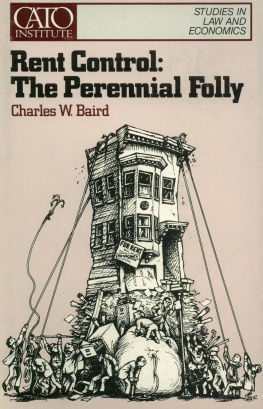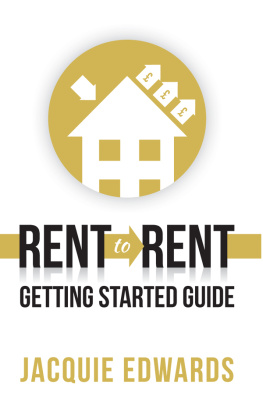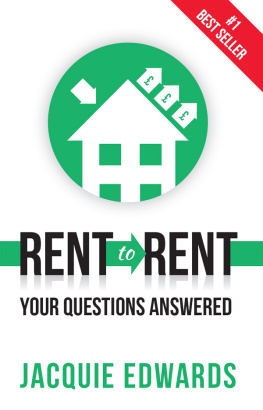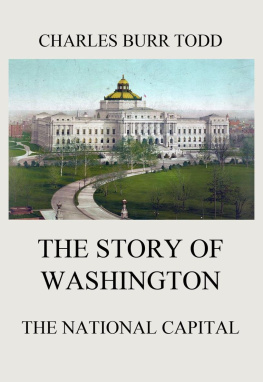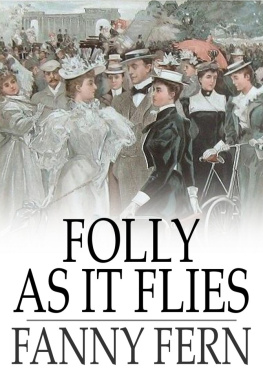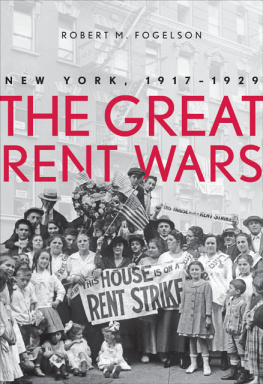Rent Control:
The Perennial Folly
Rent Control:
The Perennial Folly
Charles W. Baird
Cato Public Policy Research Monograph No. 2
INSTITUTE
Copyright 1980 by the Cato Institute.
All rights reserved.
Library of Congress Cataloging in Publication Data
Baird, Charles W.
Rent control: the perennial folly.
(Cato public policy research monograph; no. 2)
Bibliography: p.
1. Rent controlUnited States. I. Title. II. Series: Cato Institute. Cato public policy research monograph; no. 2.
ISBN: 0-932790-22-4
Printed in the United States of America.
CATO INSTITUTE
747 Front Street
San Francisco, California 94111
I. THE ORGANIZING FRAMEWORK
Scarcity and Competition
Throughout history, humans have been confronted by scarcity; which is to say that there just aren't sufficient resources to provide people with everything they would like to have. People must make choicesmore of good A means less of good B. A good is something that a person would prefer, cost aside, to have more of rather than less of. Most people consider housing, nutrition, transportation, health care, dean air, and education to be goods. With the means at his disposal, each person pursuing his own goals, constantly attempts to obtain his preferred combination of goods. The consumption of more or better housing services implies the consumption of less of something elseless pleasing forms of nutrition, less recreational travel, or maybe even less dean air. We simply are incapable, individually or collectively, of having as much as we would like to have of all goods.
Moreover, it is obvious that people do not share the same tastes, preferences, and values. One person's view of the ideal combination of new housing development, traffic density, and open space is likely to be different from another person's. If we lived in a utopia, we could all have things exactly as we would like them; but we don't, and we cannot. In all economic systems, whether based on individualism or collectivism, there must be a process whereby the competing goals and interests of the people involved are resolved. Because there is scarcity, competition for goods is inevitable.
There is no objectively definable "public interest"; there are only the interests of the individuals who together make up the public. A person who advocates using more open space to build new housing is as much a member of the public as a person who attempts to block the creation of additional housing in order to preserve a better view, a hiking trail, or the habitat of a plant. A landlord who decides, instead of improving his rental property, to invest in an enterprise that manufactures electric motors is every bit as much a member of the public as a tenant or prospective tenant who would like the rental property to be improved.
A business firm, even if it is a corporation, is merely a set of contractual relationships between individuals. The central figure is the entrepreneur, who perceives that enough people are willing and able to pay enough for some good to bring him a total revenue that is more than enough to cover all of the costs of producing the good. The entrepreneur contracts with people who supply the services of the human and nonhuman resources they own for use in the production process. Some people supply labor services, others supply the services of physical capital (tools, buildings, and machines), others supply the services of financial capital, and still others supply the services of land. When the good is produced, the entrepreneur then contracts with those who wish to acquire the good. Out of the revenue collected from customers the entrepreneur pays all of the contractual claims of the resource suppliers and keeps whatever residual is left. The residual claim is the reward to the entrepreneur for his alertness to the wants of others.
A developer does not build homes in order to look at them; he builds them in order to sell them to people who want to live in them. A lumber company that cuts timber does so in order to accommodate those who want to live in the houses that are built with the lumber. The developer and the lumber company do not compete with the public. They serve individual members of the public. A backpacker who wants timber to stand as trees competes with the person who wants to live in the house that could be built If the trees were harvested. People compete with people. It is simply fraudulent to depict business as competing with the public. Business is merely the agent of its suppliers and its actual and potential customers. It is an institution through which the competing claims of individuals over the uses of scarce resources are processed.
Rationing
Because of scarcity it is impossible for people to get all they would like to have of the many things they consider to be goods; so there must be some process to decide who gets what and how much. Rationing is the name given to that process. Rationing devices can be divided into two categories: nonprice rationing and rationing by price.
A. Nonprice Rationing
The most time-honored rationing device is violence. That is, those who have the might are those who, more than other people, get what they want. Who gets what and how much? It depends on who has the biggest club, or the biggest army, or the most hired thugs. In a society where rationing is accomplished by violence there is little or no incentive to produce. If one were to produce something it would be likely that someone else, a little better at using violence, would merely take it away. Since nothing in the violence rationing mechanism calls forth additional amounts of goods, any gain made by one person must represent a loss to some other person. Moreover, competition through violence must gradually result in the demise of the physically weak and the dominance of those who are best at using violence.


